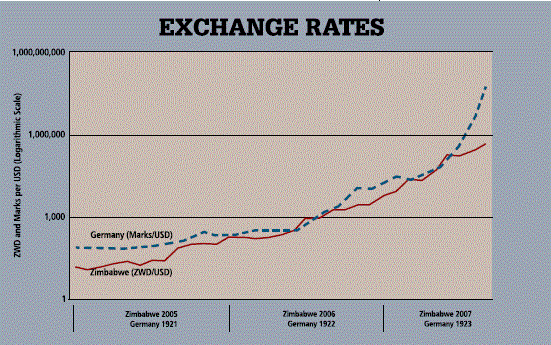
Since March 2007, Zimbabwe has been in the midst of a hyperinflation (a rate of inflation per month that exceeds 50%). This phenomenon is rather rare. Indeed, prior to Zimbabwe, there had only been 29 hyperinflations.
Zimbabwe’s hyperinflation is destroying the economy, pushing more of its inhabitants into poverty and forcing millions of Zimbabweans to emigrate. Since 1997, inflation has surged by 1,030,217%, while living standards (as measured by real GDP per capita) have fallen by 35%. In addition, hyperinflation has robbed people of their savings and financial institutions of their capital via negative real interest rates. This form of theft occurs, in large part, because the laws and regulations governing financial institutions (pension funds, insurance companies, building societies, and banks) force them to either purchase government treasury bills that yield only a small fraction of the current inflation rate or to make deposits at the Reserve Bank of Zimbabwe that pay no interest.
Not surprisingly, the value of the Zimbabwe dollar has been wiped out. The accompanying figure tells the devastating story— one that is ominously following the same plot as that taken by the mark during the great German hyperinflation of the 1920s. If all that destruction hasn’t been painful enough, worse is yet to come. Private sector economists expect Zimbabwe’s GDP to fall by 12% in 2007, and the International Monetary Fund projects that year-on-year inflation could exceed 100,000% by year-end.
As I conclude in my recent book, Zimbabwe: Hyperinflation to Growth, the most rapid and reliable way to stop hyperinflation in Zimbabwe is to replace central banking with a new monetary regime. This would signal a clean break with the practices that have created hyperinflation and give Zimbabweans reliable assurance that inflation will henceforth remain relatively low.
One monetary regime that would stop Zimbabwe’s hyperinflation is free banking. Under this system, private banks issue notes (paper money) and other liabilities with minimal regulation. A completely free banking system has no central bank, no lender of last resort, no reserve requirements, and no legal restrictions on bank portfolios, interest rates, or branch banking. Free banking systems have existed in nearly 60 countries during the 1800s and early 1900s.
Zimbabwe had free banking from the time the first bank was established in 1892 until the government replaced free banking with a currency board in 1940. Zimbabwe’s free banking was among the least restricted that ever existed. At the time, the country had only two commercial banks, the Standard Bank of South Africa and the Bank of Africa (later part of Barclays Bank). They issued notes denominated in pounds, and kept their privately issued pounds equal to the pound sterling—except during the First World War and for a few years afterwards, when the local pound floated along with the South African pound (the predecessor to the rand) against the pound sterling. Free banking ended in Zimbabwe not because it performed poorly, but because the government desired the profit from issuing notes.
One monetary regime that would stop Zimbabwe’s hyperinflation is free banking.
Although free banking might be unfamiliar, the principles of competition that underlie it are not, because they are already at work in deposit banking. We do not usually think of deposits from different banks as being different types of currency, but in effect they are—at least, they are different brands of a common unit of account. By holding a deposit at one bank rather than others, a depositor is choosing that bank’s management, portfolio, and services over those of its competitors.
Free banking extends competition from deposits to notes. In practice, multiple brands of notes have generally not created problems for free banking systems any more than multiple brands of deposits create problems in central banking or other systems.
In a system of fully free banking, the field includes anyone (domestic or foreign) who meets the requirements common to other businesses (registering a place of business, stating who the officers are, listing the shareholders periodically, and publishing financial statements if the company is not a private partnership). Competition weeds out firms that are less astute at delivering what consumers want. Abundant experience indicates that depositors want assurance that they are placing their funds with a financially solid bank.
That is why the tendency almost everywhere is for a few large but highly competitive banks to dominate the market, though leaving niches for small banks to serve specialized clienteles. As with deposit banking, then, historical experience suggests that eventually or perhaps even immediately, note issuance will be dominated by a small number of large banks.
Under free banking, banks would have the liberty to issue deposits and circulate notes in any currency—the US dollar, South African rand, gold, etc. In past free banking systems, they have converged on a single unit of account, typically gold or a foreign currency. In Zimbabwe it is quite possible they would converge on the South African rand. However, free banking leaves it for banks and customers to discover what works best for them; it does not presume that the government already knows the answers.

Author Steve H. Hanke

0 responses on "Free Banking for Zimbabwe"